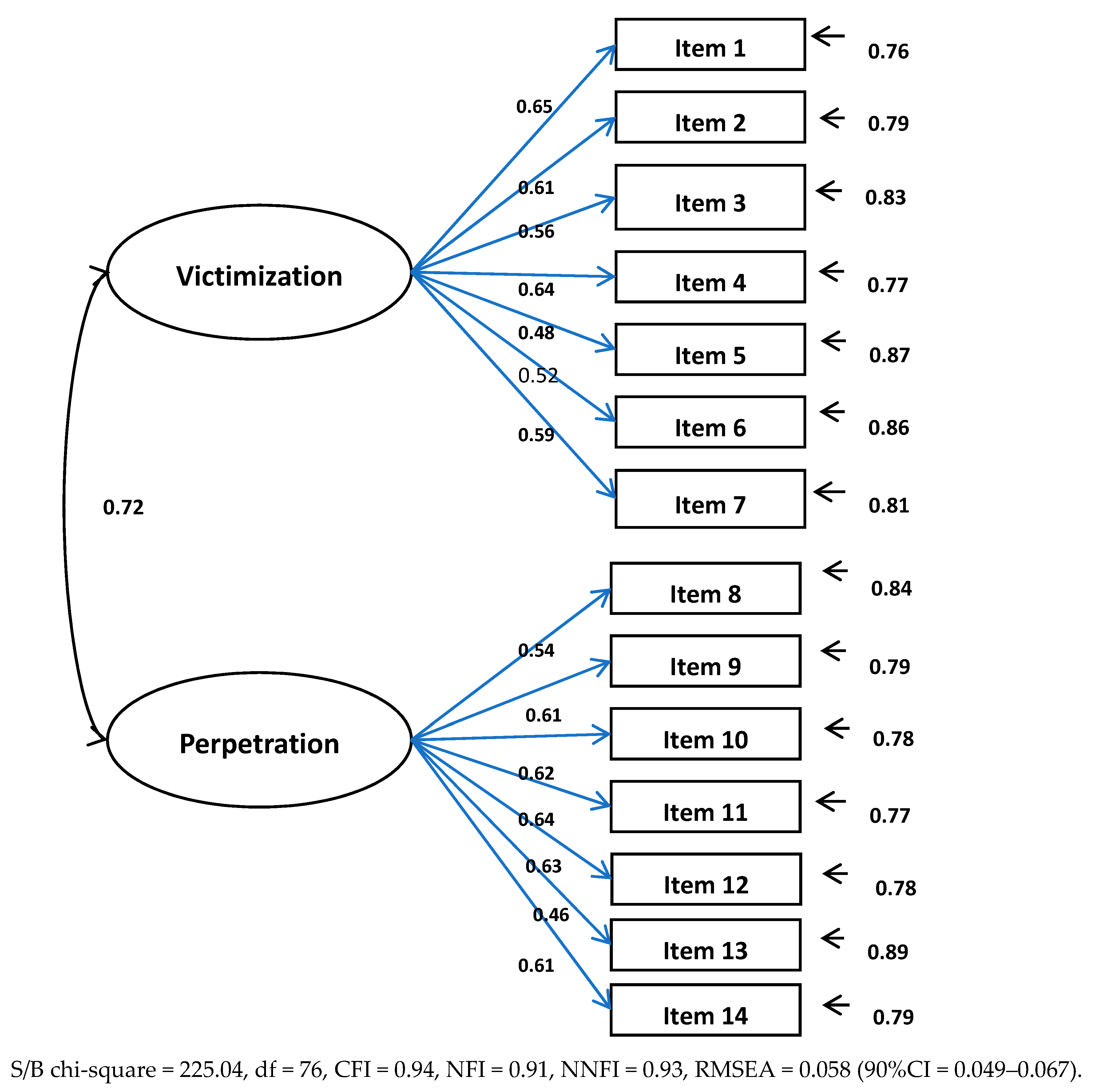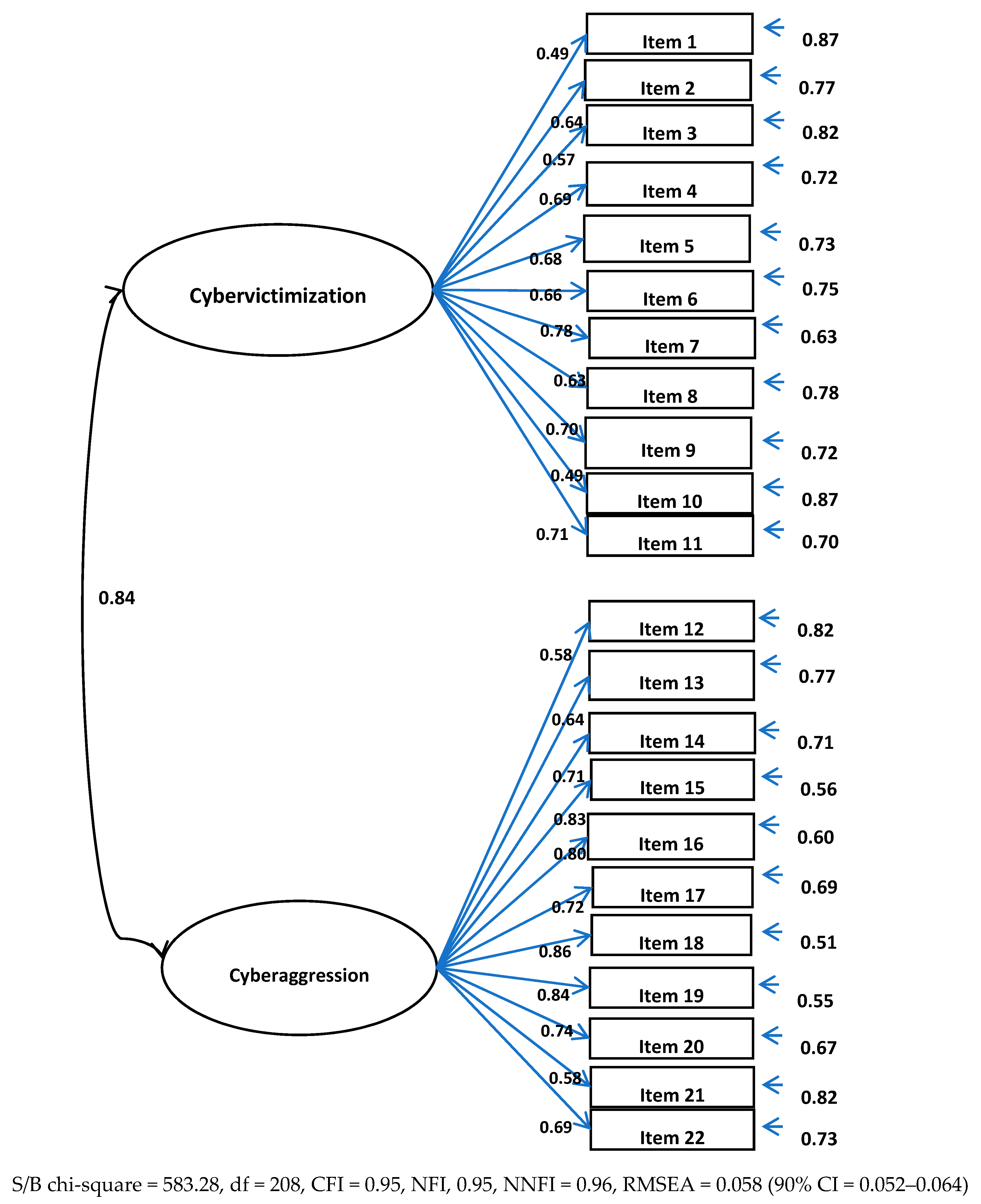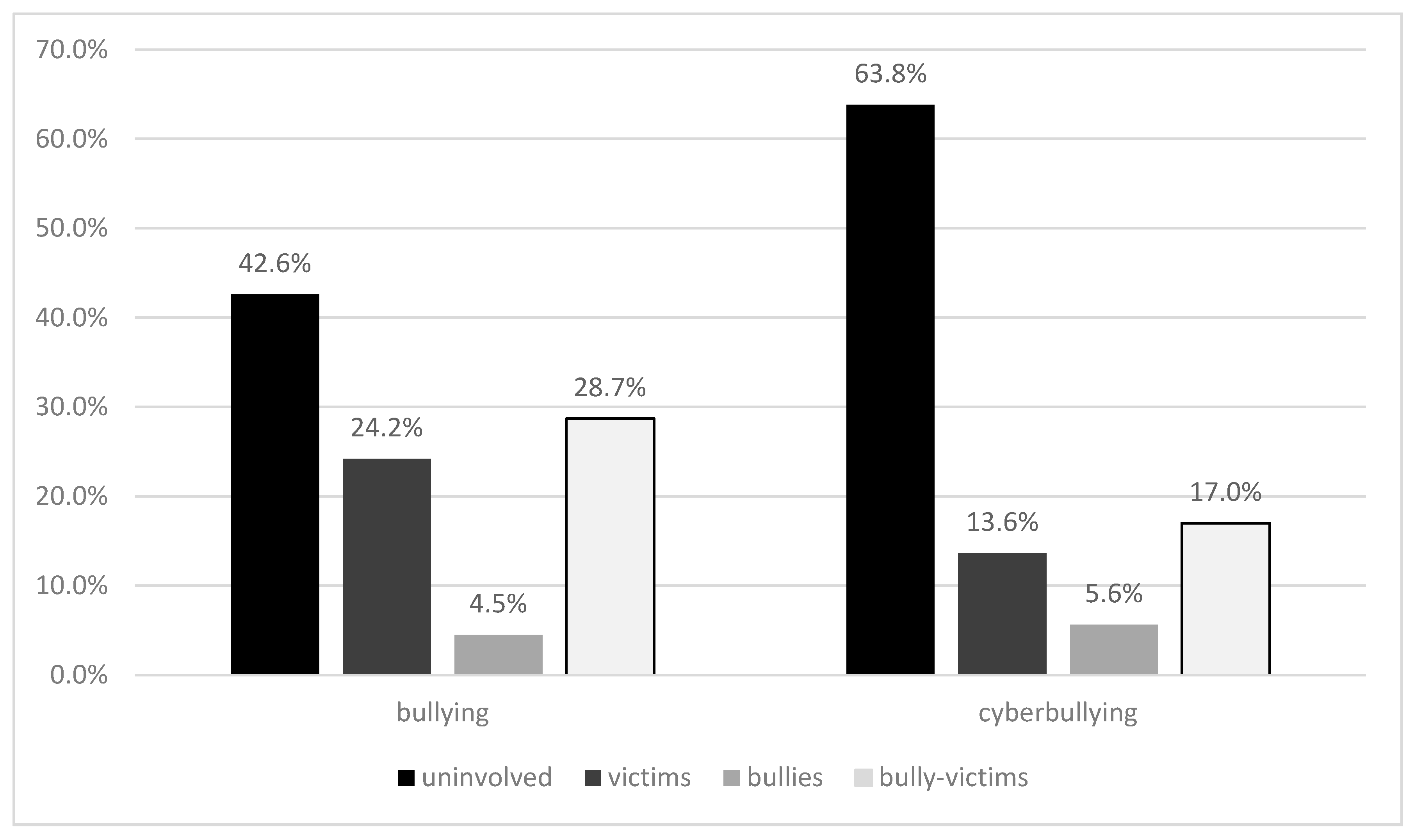Bullying and Cyberbullying in Adolescents from Disadvantaged Areas: Validation of Questionnaires; Prevalence Rates; and Relationship to Self-Esteem, Empathy and Social Skills
Abstract
:1. Introduction
1.1. Prevalence Rates of Bullying and Cyberbullying: Research in Disadvantaged Areas
1.2. Bullying and Cyberbullying: Relation to Self-Esteem, Empathy, and Social Skills
1.3. Current Study
2. Method
2.1. Participants
2.2. Instruments
2.3. Procedure
2.4. Data Analyses
3. Results
4. Discussion
5. Conclusions
Author Contributions
Funding
Acknowledgments
Conflicts of Interest
References
- Zych, I.; Ortega-Ruiz, R.; Del Rey, R. Scientific Research on Bullying and Cyberbullying: Where Have We Been and Where Are We Going. Aggress. Violent Behav. 2015, 24, 188–198. [Google Scholar] [CrossRef]
- Del Rey, R.; Ortega, R. Bullying en los países pobres: Prevalencia y coexistencia con otras formas de violencia. Int. J. Psychol. Psychol. Ther. 2008, 8, 39–50. [Google Scholar]
- Rodríguez-Hidalgo, A.J.; Pantaleón, Y.; Calmaestra, J. Psychological Predictors of Bullying in Adolescents from Pluricultural Schools: A Transnational Study in Spain and Ecuador. Front. Psychol. 2019, 10, 1383. [Google Scholar] [CrossRef]
- Smith, P.K.; Cowie, H.; Olafsson, R.F.; Liefooghe, A.P.D. Definitions of Bullying: A Comparison of Terms Used, and Age and Gender Differences, in a Fourteen-Country International Comparison. Child. Dev. 2002, 73, 1119–1133. [Google Scholar] [CrossRef]
- Ortega-Ruiz, R.; Avilés, J.M. Autoinforme Para La Evaluación Del Bullying; Autors: Valladolid, Spain, 2005. [Google Scholar]
- Rodríguez, F.J.; Gutierrez, C.; Herrero, F.J.; Hernandez, E.; Carbonero, P.G.; Jimenez, A. Violencia En El Marco Escolar de La Enseñanza Obligatoria: El Profesorado Como Referencia. Aula Abierta 2002, 79, 139–152. [Google Scholar]
- Salmivalli, C. Bullying and the Peer Group: A Review. Aggress. Violent Behav. 2010, 15, 112–120. [Google Scholar] [CrossRef]
- Menesini, E.; Nocentini, A.; Palladino, B.E.; Frisén, A.; Berne, S.; Ortega-Ruiz, R.; Calmaestra, J.; Scheithauer, H.; Schultze-Krumbholz, A.; Luik, P.; et al. Cyberbullying Definition Among Adolescents: A Comparison Across Six European Countries. Cyberpsychol. Behav. Soc. Netw. 2012, 15, 455–463. [Google Scholar] [CrossRef] [Green Version]
- Tokunaga, R.S. Following You Home from School: A Critical Review and Synthesis of Research on Cyberbullying Victimization. Comput. Hum. Behav. 2010, 26, 277–287. [Google Scholar] [CrossRef]
- Gámez-Guadix, M.; Borrajo, E.; Almendros, C. Risky Online Behaviors among Adolescents: Longitudinal Relations among Problematic Internet Use, Cyberbullying Perpetration, and Meeting Strangers Online. J. Behav. Addict. 2016, 5, 100–107. [Google Scholar] [CrossRef] [Green Version]
- Slonje, R.; Smith, P.K.; Frisén, A. The Nature of Cyberbullying, and Strategies for Prevention. Comput. Hum. Behav. 2013, 29, 26–32. [Google Scholar] [CrossRef]
- Nasaescu, E.; Zych, I.; Ortega-Ruiz, R.; Farrington, D.P.; Llorent, V.J. Longitudinal Patterns of Antisocial Behaviors in Early Adolescence: A Latent Class and Latent Transition Analysis. Eur. J. Psychol. Appl. Leg. Context 2020, 12, 85–92. [Google Scholar] [CrossRef]
- Krisch, M.; Eisner, M.P.; Mikton, C.; Butnart, A. Global Strategies to Reduce Violence by 50% in 30 Years; Institute of Criminology Violence Research Centre and World Health Organization, University of Cambridge: Cambridge, UK, 2015. [Google Scholar]
- Rodríguez-Hidalgo, A.J.; Solera, E.; Calmaestra, J. Psychological Predictors of Cyberbullying according to Ethnic-Cultural Origin in Adolescents: A National Study in Spain. J. Cross-Cult. Psychol. 2018, 49, 1506–1522. [Google Scholar]
- Herrera-López, M.; Romera, E.M.; Ortega-Ruiz, R. Bullying y ciberbullying en Latinoamérica. Rev. Mex. Investig. Educ. 2018, 23, 125–155. [Google Scholar]
- Herrera-López, M.; Casas, J.A.; Romera, E.M.; Ortega-Ruiz, R.; Del Rey, R. Validation of the European Cyberbullying Intervention Project Questionnaire for Colombian Adolescents. Cyberpsychol. Behav. Soc. Netw. 2017, 20, 117–125. [Google Scholar] [CrossRef]
- Herrera-López, M.; Romera, E.; Ortega-Ruiz, R. Bullying y cyberbullying en Colombia; coocurrencia en adolescentes escolarizados. Rev. Latinoam. Psicol. 2017, 49, 163–172. [Google Scholar] [CrossRef]
- Fleming, L.C.; Jacobsen, K.H. Bullying among Middle-School Students in Low and Middle Income Countries. Health Promot. Int. 2010, 25, 73–84. [Google Scholar] [CrossRef] [Green Version]
- Modecki, K.; Minchin, J.; Harbaugh, A.; Guerra, N.; Reunions, K. Bullying Prevalence across Contexts: A Meta-Analysis Measuring Cyber and Traditional Bullying. J. Adolesc. Health 2014, 55, 602–611. [Google Scholar]
- Brochado, S.; Soares, S.; Fraga, S. A Scoping Review on Studies of Cyberbullying Prevalence among Adolescents. Trauma Violence Abuse 2017, 18, 523–531. [Google Scholar] [CrossRef] [Green Version]
- Sorrentino, A.; Baldry, A.C.; Farrington, D.P.; Blaya, C. Epidemiology of Cyberbullying across Europe: Differences between Countries and Genders. Educ. Sci. Theory Pr. 2019, 19, 74–91. [Google Scholar] [CrossRef]
- UNICEF. Hidden in Plain Sight: A Statistical Analysis of Violence against Children; UNICEF: New York, NY, USA, 2014. [Google Scholar]
- Eljach, S. Violencia Escolar En America Latina y El Caribe: Superficie y Fondo; UNICEF Y PLAN: Panamá City, Republica de Panamá, 2011. [Google Scholar]
- Román, M.; Murillo, F.J. Latin America: School bullying and academic achievement. CEPAL Rev. 2011, 2011, 37–53. [Google Scholar] [CrossRef] [Green Version]
- Cabra, F.; Marciales, G. Cyberbullying and Education: A review of remergent issues in Latin America research. In Cyberbullying across the Globe; Springer International Publishing: New York, NY, USA, 2016; pp. 131–147. [Google Scholar]
- Ministerio de Salud. Encuesta Global de Salud Escolar: Resultados; MINSA: Lima, Perú, 2011.
- MINEDU. Reporte de Casos de Violencia Escolar En El Perú; Ministerio de educación del Perú: San Borja, Peru, 2018.
- INEI. Encuesta Nacional Sobre Relaciones Sociales (ENARES 2013—2015) Principales Resultados; Instituto Nacional de Estadística e informática: Lima, Perú, 2015. [Google Scholar]
- Gutierrez, I.A.; Molina, O.; Ñopo, H. Stand against Bullying: An Experimental School Intervention; IZA—Institute of Labor Economics: Bonn, Germany, 2018. [Google Scholar]
- Miranda, R.; Oriol, X.; Amutio, A.; Ortúzar, H. Bullying en la adolescencia y satisfacción con la vida: Puede el apoyo de los adultos de la familia y de la escuela mitigar este efecto? Rev. Psicodidáct. 2018, 24, 39–45. [Google Scholar] [CrossRef]
- Miranda, R.; Oriol, X.; Amutio, A. Risk and Protective Factors at School: Reducing Bullies and Promoting Positive Bystanders’ Behaviors in Adolescence. Scand. J. Psychol. 2019, 60, 106–115. [Google Scholar] [CrossRef]
- Manzuoli, H.; Medina, C. Cyberbullying, Detección y Factores de Análisis: Un Estudio Comparativo. Rev. Espac. 2019, 40, 4. [Google Scholar]
- van Geel, M.; Goemans, A.; Zwaanswijk, W.; Gini, G.; Vedder, P. Does Peer Victimization Predict Low Self-Esteem, or Does Low Self-Esteem Predict Peer Victimization? Meta-Analyses on Longitudinal Studies. Dev. Rev. 2018, 49, 31–40. [Google Scholar] [CrossRef] [Green Version]
- Kowalski, R.M.; Limber, S.P.; McCord, A. A Developmental Approach to Cyberbullying: Prevalence and Protective Factors. Aggress. Violent Behav. 2019, 45, 20–32. [Google Scholar] [CrossRef]
- Veenstra, R.; Lindenberg, S.; Munniksma, A.; Dijkstra, J.K. The Complex Relation between Bullying, Victimization, Acceptance, and Rejection: Giving Special Attention to Status, Affection, and Sex Differences. Child. Dev. 2010, 81, 480–486. [Google Scholar] [CrossRef] [Green Version]
- Donnellan, M.B.; Trzesniewski, K.H.; Robins, R.W.; Moffitt, T.E.; Caspi, A. Low Self-Esteem Is Related to Aggression, Antisocial Behavior, and Delinquency. Psychol. Sci. 2005, 16, 328–335. [Google Scholar] [CrossRef]
- Zych, I.; Farrington, D.P.; Ttofi, M.M. Protective Factors against Bullying and Cyberbullying: A Systematic Review of Meta-Analyses. Aggress. Violent Behav. 2019, 45, 4–19. [Google Scholar] [CrossRef]
- Tsaousis, I. The Relationship of Self-Esteem to Bullying Perpetration and Peer Victimization among Schoolchildren and Adolescents: A Meta-Analytic Review. Aggress. Violent Behav. 2016, 31, 168–199. [Google Scholar] [CrossRef]
- Chen, L.; Ho, S.; Lwin, M. A Meta-Analysis of Factors Predicting Cyberbullying Perpetration and Victimization: From the Social Cognitive and Media Effects Approach. New Media Soc. 2017, 19, 1194–1213. [Google Scholar] [CrossRef]
- Kowalski, R.M.; Giumetti, G.W.; Schroeder, A.N.; Lattanner, M.R. Bullying in the digital age: A critical review and meta-analysis of cyberbullying research among youth. Psychol. Bull. 2014, 140, 1073–1137. [Google Scholar] [CrossRef]
- Rodríguez-Hidalgo, A.J.; Ortega-Ruiz, R.; Zych, I. Peer Victimization and Ethnic-Cultural Peer Victimization: Self-Esteem and School Relations between Different Cultural Groups of Students in Andalusia, Spain // Victimización étnico-cultural entre iguales: Autoestima y relaciones en la escuela entre. Rev. Psicodidáctica 2013, 19, 191–210. [Google Scholar] [CrossRef] [Green Version]
- Jolliffe, D.; Farrington, D.P. Examining the Relationship between Low Empathy and Bullying. Aggress. Behav. 2006, 32, 540–550. [Google Scholar] [CrossRef]
- Del Rey, R.; Lazuras, L.; Casas, J.A.; Barkoukis, V.; Ortega-Ruiz, R.; Tsorbatzoudis, H. Does Empathy Predict (Cyber) Bullying Perpetration, and How Do Age, Gender and Nationality Affect This Relationship? Learn. Individ. Differ. 2016, 45, 275–281. [Google Scholar] [CrossRef]
- Jolliffe, D.; Farrington, D.P. Development and Validation of the Basic Empathy Scale. J. Adolesc. 2006, 29, 589–611. [Google Scholar] [CrossRef]
- Smith, P.K.; Thompson, D. Practical Approaches to Bullying; Fulton: London, UK, 1999. [Google Scholar]
- Fousiani, K.; Dimitropoulou, P.; Michaelides, M.P.; Van Petegem, S. Perceived Parenting and Adolescent Cyber-Bullying: Examining the Intervening Role of Autonomy and Relatedness Need Satisfaction, Empathic Concern and Recognition of Humanness. J. Child. Fam. Stud. 2016, 25, 2120–2129. [Google Scholar] [CrossRef] [Green Version]
- Zych, I.; Ttofi, M.M.; Farrington, D.P. Empathy and Callous–Unemotional Traits in Different Bullying Roles: A Systematic Review and Meta-Analysis. Trauma Violence Abus. 2016, 20, 3–21. [Google Scholar] [CrossRef]
- Ortega-Ruiz, R. Agresividad Injustificada, Bullying y Violencia Escolar; Alianza: Madrid, Spain, 2010. [Google Scholar]
- Caravita, S.C.S.; Di Blasio, P.; Salmivalli, C. Early Adolescents’ Participation in Bullying: Is ToM Involved? J. Early Adolesc. 2010, 30, 138–170. [Google Scholar] [CrossRef]
- Sutton, J.; Smith, P.K.; Swettenham, J. Social Cognition and Bullying: Social Inadequacy or Skilled Manipulation? Br. J. Dev. Psychol. 1999, 17, 435–450. [Google Scholar]
- Oliva, A. Desarrollo Positivo Adolescente y los Activos que lo Promueven: Un Studio en Centros Docentes Andaluces; Junta de Andalucía, Secretaría General de Salud Pública y Participación: Sevilla, Spain, 2011. [Google Scholar]
- Horne, A.M.; Socherman, R. Profile of a Bully: Who Would Do Such a Thing? Educ. Horiz. 1996, 74, 77–83. [Google Scholar]
- Perren, S.; Alekader, F.D. Social Behavior and Peer Relationships of Victims, Bully-Victims, and Bullies in Kindergarten. J. Child. Psychol. Psychiatry 2006, 47, 45–57. [Google Scholar] [CrossRef]
- Rupp, S.; Elliot, S.N.; Gresham, F.M. Assessing Elementary Students’ Bullying and Related Social Behaviors: Cross-Informant Consistency across School and Home Environments. Child. Youth Serv. Rev. 2018, 93, 458–466. [Google Scholar] [CrossRef]
- Sterzing, P.R.; Shattuck, P.T.; Narendorf, S.C.; Wagner, M.; Cooper, B.P. Bullying Involvement and Autism Spectrum Disorders: Prevalence and Correlates of Bullying Involvement among Adolescents with an Autism Spectrum Disorder. Arch. Pediatr. Adolesc. Med. 2012, 166, 1058–1064. [Google Scholar] [CrossRef]
- Cook, C.R.; Williams, K.R.; Guerra, N.G.; Kim, T.E.; Sadek, S. Predictors of Bullying and Victimization in Childhood and Adolescence: A Meta-Analytic Investigation. Sch. Psychol. Q. 2010, 25, 65–83. [Google Scholar] [CrossRef] [Green Version]
- Heydenberk, R.A.; Heydenberk, W.R.; Tzenova, V. Conflict Resolution and Bully Prevention: Skills for School Success. Confl. Resolut. Q. 2006, 24, 55–69. [Google Scholar] [CrossRef]
- Jenkins, L.N.; Demaray, M.K.; Fredrick, S.S.; Summers, K.H. Associations among Middle School Students’ Bullying Roles and Social Skills. J. Sch. Violence 2014, 15, 259–278. [Google Scholar] [CrossRef]
- Katzer, C.; Fetchenchauer, D.; Belschak, F. Cyberbullying: Who Are the Victims? A Comparison of Victimization in Internet Chatrooms and Victimization in School. J. Media Psychol. 2009, 21, 25–36. [Google Scholar] [CrossRef]
- Bagwell, C.; Schmidt, M.E. The Friendship Quality of Overtly and Relationally Victimized Children. J. Dev. Psychol. 2011, 57, 158–185. [Google Scholar] [CrossRef]
- Ortega-Ruiz, R.; Del Rey, R.; Casas, J.A. Evaluar el bullying y el cyberbullying validación española del EBIP-Q y del ECIP-Q. Psicol. Educ. 2016, 22, 71–79. [Google Scholar] [CrossRef] [Green Version]
- Twardowska-Staszek, E.; Zych, I.; Ortega-Ruiz, R. Bullying and Cyberbullying in Polish Elementary and Middle Schools: Validation of Questionnaires and Nature of the Phenomena. Child. Youth Serv. Rev. 2018, 95, 217–225. [Google Scholar] [CrossRef]
- Del Rey, R.; Casas, J.A.; Ortega-Ruiz, R.; Schultze-Krumbholz, A.; Scheithauer, H.; Smith, P.; Thompson, F.; Barkoukis, V.; Tsorbatzoudis, H.; Brighi, A.; et al. Structural Validation and Cross-Cultural Robustness of the European Cyberbullying Intervention Project Questionnaire. Comput. Hum. Behav. 2015, 50, 141–147. [Google Scholar] [CrossRef]
- Viejo, C. Dating Violence y Cortejo Adolescente: Un Estudio Sobre La Violencia En Las Parejas Sentimentales de Los Jóvenes Andaluces [Dating Violence and Courting in Youths: A Study on Violence in Romantic Partners in Andalusian Youths]; Universidad de Córdoba: Córdoba, España, 2012. [Google Scholar]
- Bentler, R.M.; Wu, E.J.C. EQS for Windows (Version 6.2) [Statistical Program for Windows]; Multivariate Software: Encino, CA, USA, 2012. [Google Scholar]
- Hu, L.; Bentler, P.M. Cut-off Criteria for Fit Indexes in Covariance Structure Analysis: Conventional Criteria versus New Alternatives. Struct. Equ. Model. Multidiscip. J. 1999, 6, 1–55. [Google Scholar]
- Lorenzo-Seva, U.; Ferrando, P.J. FACTOR 10; Universitat Rovira I Virgili: Murcia, Spain, 2015. [Google Scholar]
- IBM. IBM SPSS Statistics for Windows; (Version 24); IBM Corp.: New York, NY, USA, 2011. [Google Scholar]



| Roles | Uninvolved in Cyberbullying | Cybervictim | Cyberbully | Cyberbully/Victim |
|---|---|---|---|---|
| Uninvolved in bullying | 36.7% | 3.1% | 1.2% | 1.7% |
| Victim | 15.5% | 5.2% | 0.8% | 3.3% |
| Bully | 2.3% | 1% | 0.8% | 0.4% |
| Bully-victim | 9.9% | 4.3% | 2.5% | 11.3% |
| Study Variables | 1 | 2 | 3 | 4 | 5 | 6 | 7 | 8 | 9 |
|---|---|---|---|---|---|---|---|---|---|
| 1. Victimization | 1 | ||||||||
| 2. Bullying perpetration | 398 ** | 1 | |||||||
| 3. Cybervictimization | 0.468 ** | 0.323 ** | 1 | ||||||
| 4. Cyberperpetration | 0.347 ** | 0.471 ** | 0.603 ** | 1 | |||||
| 5. Self-esteem | −215 ** | −0.083 | −0.152** | −0.111 * | 1 | ||||
| 6. Affective empathy | 0.205 ** | 0.012 | 0.165 ** | 0.071 | 0.005 | 1 | |||
| 7. Cognitive empathy | 0.133 ** | 0.008 | 0.091 * | −0.021 | 0.163 ** | 0.591 ** | 1 | ||
| 8. Communicative skills | 0.068 | −0.016 | −0.004 | −0.004 | −0.092 * | 0.248 ** | 0.192 ** | 1 | |
| 9. Assertiveness | −0.041 | −0.111** | 0.004 | −0.117 ** | 0.217 ** | 0.348 ** | 0.437 ** | 0.307 ** | 1 |
| 10. Conflict resolution | −0.001 | −0.057 | 0.038 | −0.049 | 0.171 ** | 0.389 ** | 0.395 ** | 0.270 ** | 0.612 ** |
| Predictors | Victims | Bullies | Bully-Victims |
|---|---|---|---|
| OR (95% CI) | OR (95% CI) | OR (95% CI) | |
| Age | 1.04 (0.89−1.21) | 0.98 (0.74−1.30) | 1.22 (1.06−1.41) |
| Male | 1.21 (0.71−2.08) | 2.80 (0.94−8.36) | 2.60 (1.54−4.38) |
| Self-esteem | 0.91 (0.85−0.97) | 1.03 (0.90−1.18) | 0.91 (0.86v0.97) |
| Affective empathy | 1.10 (1.01−1.19) | 1.10 (0.94−1.29) | 1.03 (0.96−1.11) |
| Cognitive empathy | 1.06 (0.98−1.15) | 0.94 (0.82−1.08) | 1.05 (0.98−1.12) |
| Communicative skills | 1.03 (0.99−1.07) | 1 (0.93−1.06) | 0.99 (0.96−1.02) |
| Assertiveness | 0.93 (0.86−1) | 1.25 (1.04−1.50) | 0.90 (0.84−0.97) |
| Conflict resolution | 0.96 (0.90−1.02) | 0.92 (0.82−1.02) | 1.02 (0.96−1.08) |
| Predictors | Cybervictims | Cyberbullies | Cyberbully-Victims |
|---|---|---|---|
| OR (95% CI) | OR (95% CI) | OR (95% CI) | |
| Age | 1.27 (1.06−1.52) | 1.25 (0.96−1.63) | 1.19 (1.01−1.40) |
| Male | 0.79 (0.41−1.49) | 2.12 (0.76−5.91) | 1.85 (1.01−3.39) |
| Self-esteem | 0.97 (0.89−1.04) | 0.96 (0.85−1.08) | 0.93 (0.86−.99) |
| Affective empathy | 0.92 (0.84−1.01) | 1.22 (1.04−1.44) | 1.11 (1.01−1.22) |
| Cognitive empathy | 1.11 (1.02−1.21) | 0.95 (0.83−1.09) | 1 (0.92−1.09) |
| Social skills | 0.99 (0.95−1.03) | 0.98 (0.92−1.05) | 0.99 (0.95−1.03) |
| Assertiveness | 1.04 (0.95−1.15) | 0.93 (0.81−1.07) | 0.94 (0.86−1.02) |
| Conflict resolution | 0.98 (0.91−1.05) | 0.94 (0.84−1.05) | 1.02 (0.95−1.09) |
© 2020 by the authors. Licensee MDPI, Basel, Switzerland. This article is an open access article distributed under the terms and conditions of the Creative Commons Attribution (CC BY) license (http://creativecommons.org/licenses/by/4.0/).
Share and Cite
Martínez, J.; Rodríguez-Hidalgo, A.J.; Zych, I. Bullying and Cyberbullying in Adolescents from Disadvantaged Areas: Validation of Questionnaires; Prevalence Rates; and Relationship to Self-Esteem, Empathy and Social Skills. Int. J. Environ. Res. Public Health 2020, 17, 6199. https://doi.org/10.3390/ijerph17176199
Martínez J, Rodríguez-Hidalgo AJ, Zych I. Bullying and Cyberbullying in Adolescents from Disadvantaged Areas: Validation of Questionnaires; Prevalence Rates; and Relationship to Self-Esteem, Empathy and Social Skills. International Journal of Environmental Research and Public Health. 2020; 17(17):6199. https://doi.org/10.3390/ijerph17176199
Chicago/Turabian StyleMartínez, Jacinto, Antonio J. Rodríguez-Hidalgo, and Izabela Zych. 2020. "Bullying and Cyberbullying in Adolescents from Disadvantaged Areas: Validation of Questionnaires; Prevalence Rates; and Relationship to Self-Esteem, Empathy and Social Skills" International Journal of Environmental Research and Public Health 17, no. 17: 6199. https://doi.org/10.3390/ijerph17176199
APA StyleMartínez, J., Rodríguez-Hidalgo, A. J., & Zych, I. (2020). Bullying and Cyberbullying in Adolescents from Disadvantaged Areas: Validation of Questionnaires; Prevalence Rates; and Relationship to Self-Esteem, Empathy and Social Skills. International Journal of Environmental Research and Public Health, 17(17), 6199. https://doi.org/10.3390/ijerph17176199







